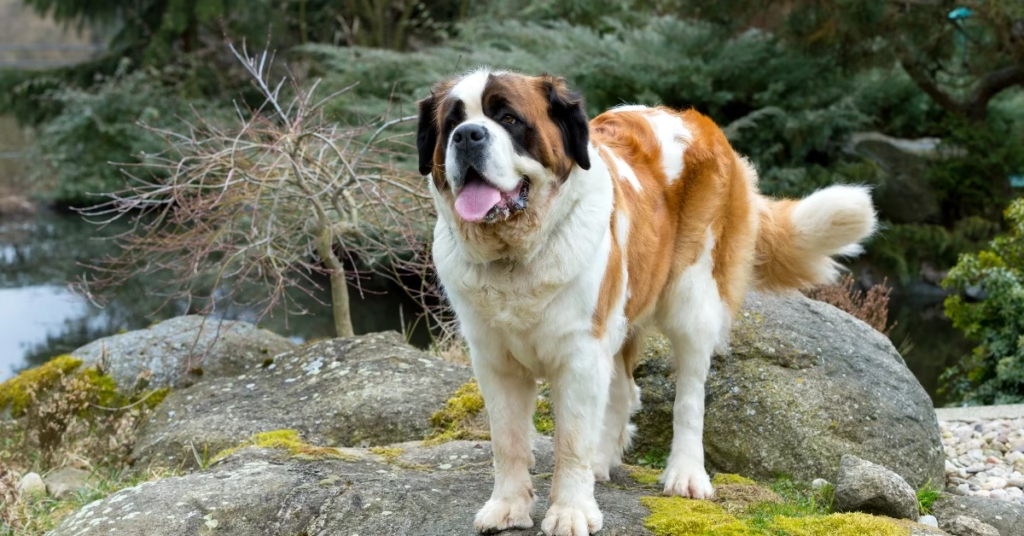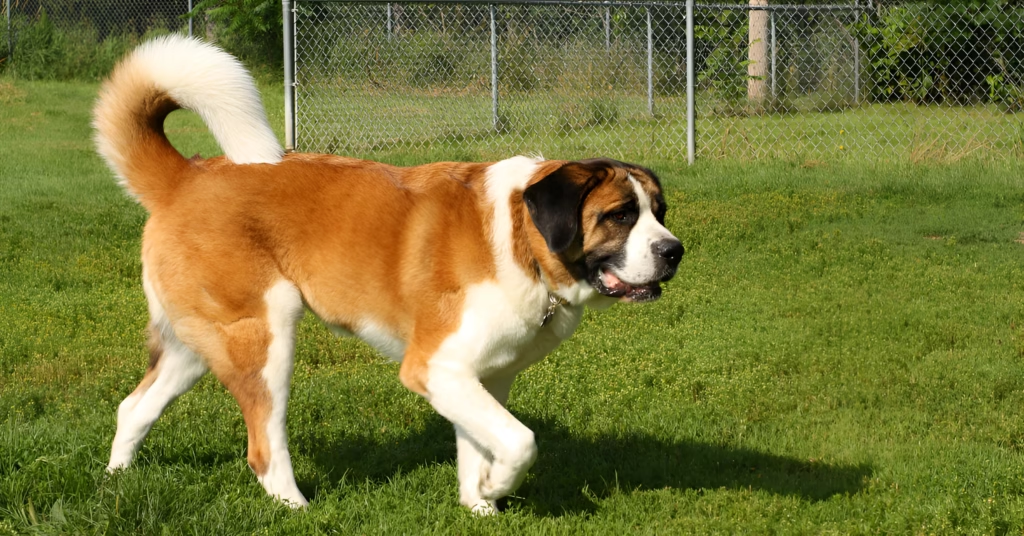The Saint Bernard is one of the world’s most iconic giant dog breeds, known for its calm temperament, expressive face, and legendary Alpine rescue history. Whether you’re drawn to their heroic past or their loving nature as a family companion, the Saint Bernard breed dog offers a unique blend of strength and gentleness.
Families often choose a Saint Bernard puppy for its affectionate personality and protective instincts. Despite their imposing size, Saint Bernard dogs are famously patient with children and remarkably adaptable to home life when given proper space, training, and exercise. This guide explores everything from their fascinating history to detailed care tips, including nutrition, training, and grooming, to help prospective owners understand the commitment of raising such a noble breed.
History and Origin of the Saint Bernard
Monastic Beginnings in the Swiss Alps
The story of the Saint Bernard begins high in the Swiss Alps at the Great St. Around the 11th century, Augustinian monks established the Great St. Bernard Hospice, where they bred large mountain dogs to help guard the monastery and assist travelers stranded in snow and avalanches.
These early dogs were ancestors of the modern Saint Bernard breed dog, selected for strength, intelligence, and an uncanny sense of direction in blizzard conditions. Their thick double coat and massive build allowed them to withstand extreme cold, making them indispensable rescue partners.
Famous Rescues and Legends
One of the most famous tales involves a heroic Napoleon Saint Bernard who saved numerous travelers from deadly snowstorms. Though the association with Napoleon may be part legend, it illustrates how deeply these dogs are tied to Alpine history.
The breed’s enduring symbol—the small cask of brandy worn around their neck, known as the Saint Bernard barrel, is more myth than fact. Historical records show no evidence that the monks equipped their dogs with brandy. Still, the image became immortal after 19th-century artists and writers romanticized their rescues.
Breed Overview at a Glance
Key Statistics Table
| Feature | Details |
|---|---|
| AKC Group | Working |
| Average Height | 26–30 inches |
| Average Weight | 120–180 lbs |
| Life expectancy of the Saint Bernard dog | 8–10 years |
| Coat Types | Short- and long-haired |
| Temperament | Gentle, patient, protective |
Appearance and Varieties

Standard Colors and Coat Types
The Saint Bernard is instantly recognizable for its majestic, well-balanced build and striking coat patterns. Traditional coloration combines white with shades of red, mahogany, or brindle. These markings can appear in saddles, masks, and ear patches, giving each dog a unique look.
Among these patterns, the Black Saint Bernard is a rare but captivating variation. Though not a separate breed, dogs with a predominantly black coat stand out for their dramatic appearance and are occasionally sought after by enthusiasts.
Two coat types exist: short-haired (smooth) and long-haired. The short-haired variety is closer to the original Alpine rescue dogs because it sheds snow and ice more easily. Long-haired Saints, while equally beautiful, require more frequent brushing to prevent mats.
Unique Mixes and Mini Breeds
Over time, breeders and families have explored designer mixes that combine the gentle nature of the Saint Bernard breed dog with other beloved breeds:
- Miniature Saint Bernard and Mini Saint Bernard: These smaller companions are usually a cross between a Saint Bernard and a Cocker Spaniel or another mid-sized breed. They keep the Saint’s affectionate personality but are easier to manage in smaller homes.
- Great Pyrenees Saint Bernard mix: This pairing produces a massive, double-coated dog with the guarding instincts of the Pyrenees and the sweet demeanor of a Saint.
- Saint Bernard Bernese Mountain Dog mix (also called Bernese Mountain Dog Saint Bernard): Known for exceptional family loyalty and a plush, tricolor coat.
- Saint Bernard and Poodle mix or Saint Bernard Poodle mix: Often called the “Saint Berdoodle,” this hybrid adds hypoallergenic potential and heightened intelligence thanks to the Poodle parent.
- Saint Bernard golden retriever mix: Combines the retriever’s sunny disposition with the Saint’s calm strength. Ideal for active families.
While these mixes offer appealing traits, prospective owners should research each combination’s health and exercise needs. Giant-breed genetics can still mean large size, even in “mini” forms.
Temperament and Personality
Family-Friendly Nature
The hallmark of Saint Bernard temperament is unwavering gentleness. Despite their size, these dogs are famously patient and affectionate, making them excellent companions for families with children. Their instinct to nurture extends to other household pets when they’re properly socialized.
A Saint Bernard puppy quickly becomes a devoted family member, craving companionship and affection. Early training ensures that their large adult size never becomes a problem for small children or older adults.
Protective but Gentle
Bred as rescue dogs, Saint Bernard dogs have an inherent protective streak. They are alert to strangers but rarely aggressive, preferring to position themselves calmly between their loved ones and potential danger. Their deep bark is usually enough to discourage intruders.
Intelligence and Trainability
These gentle giants are intelligent and eager to please, which makes them responsive to positive-reinforcement training. However, their independent streak and sometimes slow maturity mean consistent, patient training is essential, especially during the Saint Bernard puppy stage when habits form.
Because of their size, early obedience lessons, sit, stay, and leash manners are critical. A playful young Saint can unintentionally knock someone over if not taught proper boundaries.
Training and Exercise Needs

Early Socialization and Obedience
Training a Saint Bernard puppy should begin as soon as it arrives home. Early socialization with other pets, children, and strangers ensures a well-mannered adult. Because these dogs grow rapidly, teaching commands like sit, stay, and heel before they reach full size is essential.
Positive reinforcement, treats, praise, and gentle consistency work far better than harsh corrections. Group puppy classes can also help a young Saint Bernard learn polite play and proper leash behavior.
Fun Activities and Saint Bernard Dog Sports
Although not a high-energy breed, the Saint Bernard benefits from daily exercise to maintain muscle tone and a healthy weight. Two or three moderate walks plus short play sessions each day are ideal.
Some owners introduce their dogs to Saint Bernard sports such as cart pulling or weight pulling, harking back to the breed’s Alpine rescue roots. Light backpacking or hiking on cool days can also be enjoyable, but avoid strenuous activity in hot weather, as their heavy coat and large body make them prone to overheating.
Grooming and Health Care
Coat Maintenance
The double coat of the Saint Bernard breed dog requires regular grooming. Brush at least three times a week to control shedding and keep the fur free of mats. During heavy seasonal sheds, spring and fall. Daily brushing is best.
Bathing every six to eight weeks helps maintain a clean, odor-free coat. Long-haired Saints need slightly more attention to prevent tangling, while the short-haired variety still benefits from regular brushing to distribute natural oils.
Common Health Concerns
Like many giant breeds, Saint Bernard dogs are susceptible to several health issues:
- Hip and Elbow Dysplasia: Joint malformation that can cause pain and lameness.
- Heart Conditions: Including dilated cardiomyopathy.
- Bloat (Gastric Torsion): A life-threatening condition requiring immediate veterinary attention.
Routine vet checkups, weight management, and proper exercise significantly reduce these risks.
Life Expectancy
The life expectancy of Saint Bernard dog averages 8–10 years. Providing a balanced diet, regular exercise, and preventive vet care can help many Saints live longer, healthier lives.
Feeding and Nutrition
Daily Dietary Needs
The Saint Bernard is a large, slow-metabolism breed, so nutrition must support steady growth without encouraging obesity. High-quality large-breed dog food, either premium commercial formulas or a vet-approved home-cooked plan, is essential.
Nutrition Table
| Age/Activity Level | Recommended Calories | Key Nutrients |
|---|---|---|
| Puppy | 3,500–4,500 kcal/day | High protein, balanced calcium for joint growth |
| Adult | 2,500–3,000 kcal/day | Moderate protein, glucosamine for joints |
| Senior | 2,000–2,500 kcal/day | Lower fat, higher fiber to maintain weight |
Feed puppies several small meals daily to avoid bloat and support controlled growth. Adults generally do well on two evenly spaced meals.
Supplements for Healthy Joints
Many owners add omega-3 fatty acids, glucosamine, and chondroitin to support joint health. Always consult a veterinarian before introducing supplements to ensure proper dosage.
Hydration and Special Considerations
Because of their size and thick coat, Saint Bernard dogs need constant access to fresh water, especially in warm weather. Elevated feeding bowls can reduce strain on the neck and shoulders, but should be used cautiously if bloat is a concern.
Raising a Saint Bernard Puppy

Growth Stages
Bringing home a Saint Bernard puppy is an exciting adventure that requires careful planning. These gentle giants grow rapidly, often reaching 100 pounds within their first year. Growth plates don’t fully close until around 18 months, so controlled nutrition and moderate exercise are vital to avoid joint problems.
From 8 to 12 weeks, a Saint Bernard puppy is highly impressionable. Crate training and early socialization during this stage help develop a confident, well-mannered adult. By six months, they can learn advanced commands like “leave it” and “stay,” which are crucial for a large, powerful breed.
Training and Socialization Tips
Consistency is key. Use positive reinforcement, praise, treats, and short sessions to build trust and maintain focus. Because Saints mature slowly, patience is essential. Avoid excessive stair climbing or long jogs during the puppy stage to protect growing joints.
Daily gentle walks and mental stimulation, such as puzzle toys or short obedience drills, keep a young Saint Bernard happy and healthy.
Adoption, Rescue & Buying Tips
Working with Saint Bernard Rescue Groups
Adopting through a Saint Bernard rescue organization is a compassionate way to give a loving dog a second chance. Many rescues evaluate each dog’s temperament, provide medical care, and match them with suitable homes. Adoption fees are generally lower than the cost of purchasing from a breeder, making rescue a budget-friendly and rewarding option.
Finding a Reputable Breeder or Saint Bernard for Sale
If you choose to purchase a puppy, research breeders thoroughly. A reputable breeder offers health clearances, transparent lineage information, and clean, humane living conditions.
When searching for a Saint Bernard for sale, avoid puppy mills or online ads with vague details. Visit the breeder in person to ensure the dogs are healthy and well-socialized.
Understanding Saint Bernard Price
The average Saint Bernard dog price ranges from $1,000 to $3,000, depending on pedigree, location, and breeder reputation. Show-quality or rare-colored puppies, such as the Black Saint Bernard, may cost more.
Factor in lifetime expenses: high-quality food, grooming, veterinary care, and potential health treatments can add several thousand dollars per year. Responsible budgeting ensures you can meet the breed’s long-term needs.
Designer & Mixed Breeds
Popular Crosses
Several delightful Saint Bernard mix options have emerged, combining the breed’s gentle temperament with other beloved dogs:
- Saint Bernard and Poodle mix / Saint Bernard Poodle mix: Known as the “Saint Berdoodle,” this cross inherits the Poodle’s intelligence and potential low-shedding coat, appealing to allergy-sensitive households.
- Saint Bernard golden retriever mix: Friendly and active, this hybrid blends the Golden’s playful energy with the Saint’s calm nature, great for families who enjoy outdoor activities.
- Great Pyrenees Saint Bernard mix: A massive, majestic dog with strong protective instincts and a thick double coat, ideal for cold climates.
- Saint Bernard Bernese Mountain Dog mix / Bernese Mountain Dog Saint Bernard: Known for affectionate personalities and stunning tri-color coats.
Considerations Before Choosing a Mix
While these designer breeds can inherit appealing qualities, potential owners should research the unique health risks of each combination. Large or giant size often remains a factor, even when one parent is smaller. Consistent training, regular exercise, and high-quality nutrition remain critical for all Saint Bernard mix variations.
👉 Learn more about this amazing breed here: thepetdiary.com
Conclusion of Saint Bernard Dog:
Owning a Saint Bernard breed dog is a rewarding experience for those prepared for the responsibilities of a giant breed. Key points to remember:
- Size & Space: Provide ample room and a secure yard.
- Exercise & Training: Moderate daily walks and early obedience training keep them fit and well-mannered.
- Grooming & Health: Regular brushing, vet visits, and a balanced diet help extend the life expectancy of Saint Bernard dog to the upper end of 8–10 years.
- Companionship: These dogs thrive on human interaction and should never be left isolated for long periods.
Whether you adopt from a Saint Bernard rescue, fall in love with a miniature Saint Bernard, or seek a designer cross like the Saint Bernard golden retriever mix, the breed’s affectionate nature and rich history make it an unforgettable addition to any loving home.


